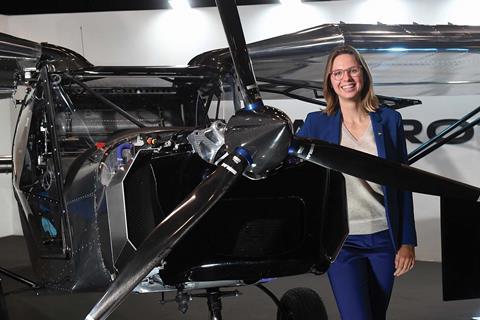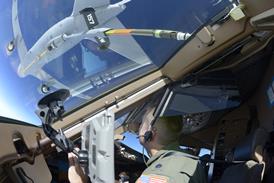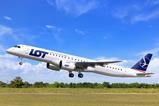Start-up Beyond Aero is making its EBACE debut as it transitions from its now-completed demonstrator flight-test programme to development of an 8-10-passenger business aircraft powered by hydrogen.
The French company is showcasing its hydrogen-powered demonstrator – a heavily modified twin-seat GI Aviation Spyl-XL ultralight – near the entrance of the exhibition hall.

Its focus now is on advancing the design of Beyond Aero One, a conceptual business aircraft powered by hydrogen fuel cells that it aims to have in service around 2030.
“It’s a clean-sheet design. The aircraft is built around the hydrogen,” says Beyond Aero chief executive and co-founder Eloa Guillotin. “You have two main technical challenges: one is the position of the tanks and second is the cooling system.”
Beyond Aero is unique in being a start-up tackling the difficult challenge of developing an entirely new hydrogen-powered aircraft. Some competing start-ups have been focused more narrowly on developing hydrogen propulsion systems for aircraft and on introducing hydrogen-converted variants of existing aircraft types. Airbus, notably, has also been studying a clean-sheet hydrogen-powered aircraft.
Beyond Aero has already accomplished much, having modified and test flown the demonstrator, which it calls Bleriot after the pioneering French aviator.
The company replaced the demonstrator’s petrol-burning engine with a hybrid propulsion system composed of batteries providing maximum power of 40kW and a hydrogen fuel cell generating up to 45kW. The configuration has the fuel cell strapped to the demonstrator’s right-side cockpit seat and fed by three hydrogen tanks located to the rear.
Beyond Aero earlier this year completed the demonstrator’s flight-test programme, which involved 10 flights, among them two “complete” tests during which the team evaluated all the aircraft’s systems together, says Guillotin.
“It’s not often you can put an electric aircraft in the air,” says Guillotin, noting only a handful of companies have done so.
Beyond Aero faces the lengthy and complex process of developing and certificating the clean-sheet business aircraft, which it says will have 800nm (1,482km) of range. It remains in the early stages of development, and Guillotin notes that hydrogen aircraft require unique designs to accommodate large and heavy hydrogen tanks.
“You need to rethink the architecture,” she says, adding that Aero One will be designed “around” the tanks.
Potential buyers have expressed interest in orders that the company values at $646 million. Beyond Aero has been working with aviation regulators from the start but faces a long road to certification.
“The main big challenge is, it’s going to be hard to certify. And that’s what makes a difference between the start-up and an OEM,” she says.
“Aviation will be electric,” Guillotin adds. “It is going to happen. The question is when.”































